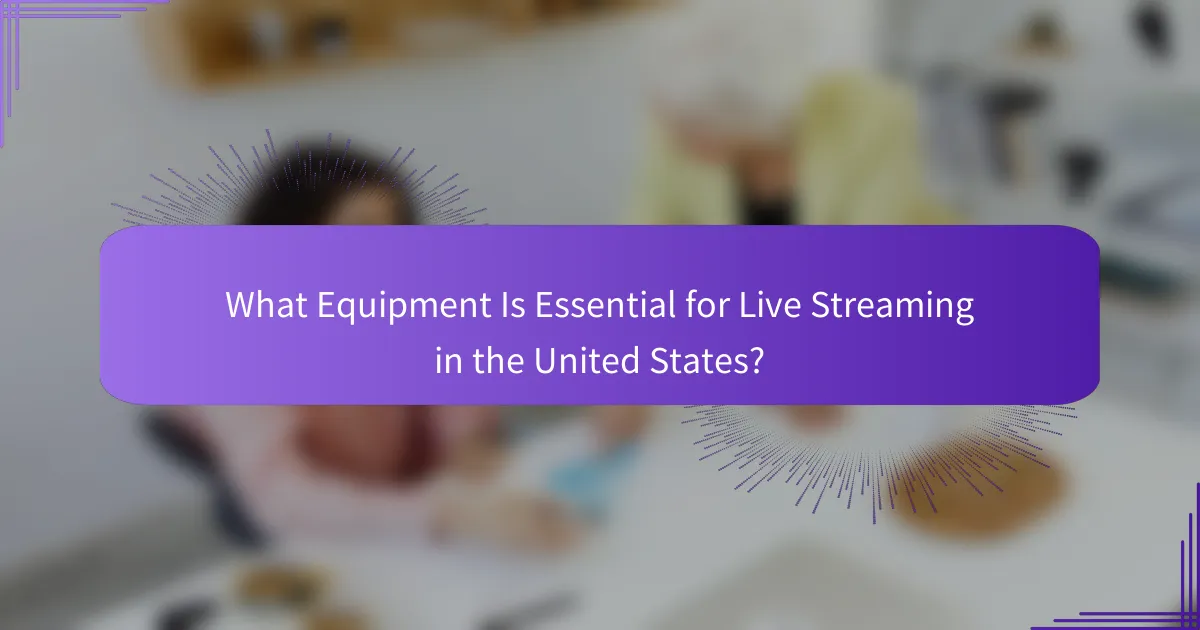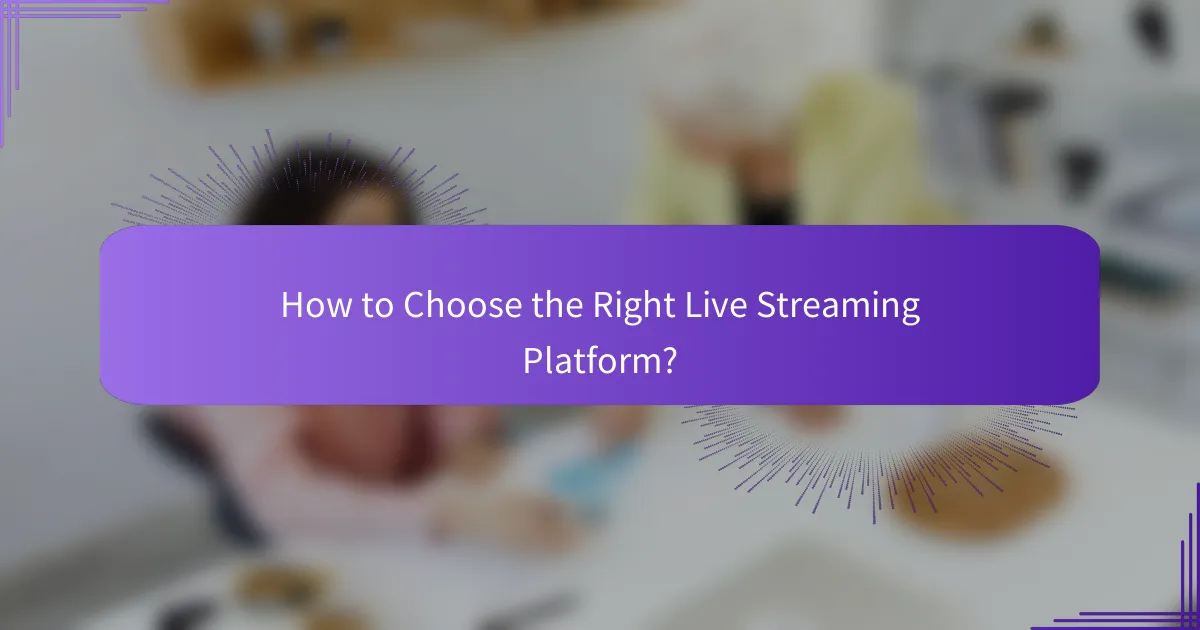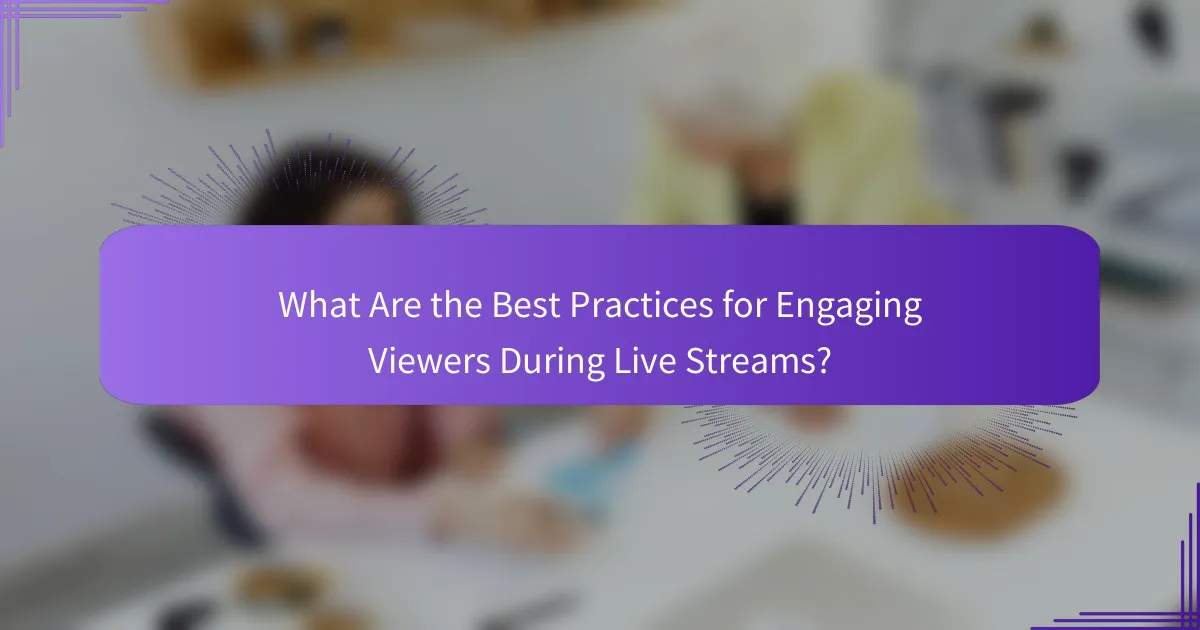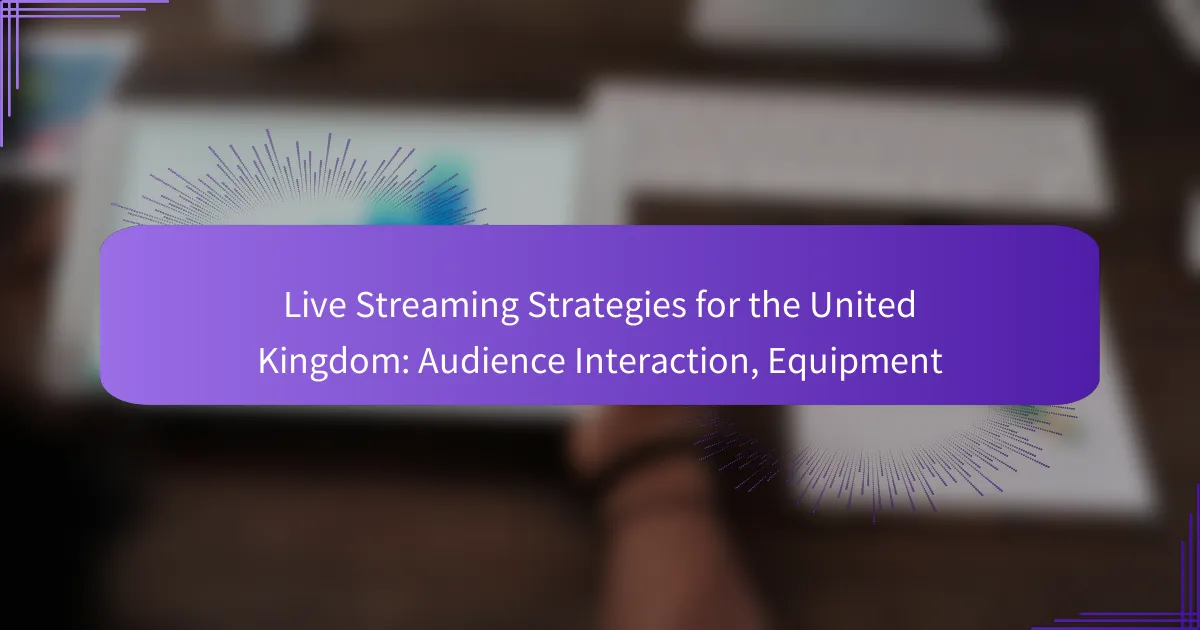In the competitive landscape of live streaming in the United States, effective strategies for audience interaction are vital for enhancing viewer engagement and satisfaction. By leveraging high-quality equipment and interactive methods, streamers can create a professional and immersive experience that resonates with their audience.

What Are Effective Live Streaming Strategies for Audience Interaction in the United States?
Effective live streaming strategies for audience interaction in the United States focus on engaging viewers in real-time and enhancing their overall experience. Utilising various interactive methods can significantly boost viewer participation and satisfaction during live broadcasts.
Real-time Polling
Real-time polling allows streamers to gauge audience opinions instantly, making viewers feel involved in the content. By using platforms that support live polls, streamers can create quick surveys on topics relevant to the stream, such as preferences or predictions.
Consider using tools like Slido or Poll Everywhere, which integrate seamlessly with popular streaming platforms. Aim to keep polls short, ideally under 30 seconds, to maintain engagement without losing viewer interest.
Live Q&A Sessions
Live Q&A sessions provide an opportunity for viewers to ask questions directly, fostering a sense of community. Streamers can allocate specific time slots during their broadcast for audience inquiries, enhancing interaction and making the content more relatable.
Encourage viewers to submit questions via chat or social media. To manage time effectively, prioritise questions based on popularity or relevance, ensuring that the most pressing topics are addressed first.
Chat Moderation Techniques
Effective chat moderation is crucial for maintaining a positive environment during live streams. Designate moderators who can manage comments, highlight engaging discussions, and filter out inappropriate content to keep the chat focused and enjoyable.
Utilise moderation tools available on platforms like Twitch or YouTube, which allow for automated filtering of harmful language. Establish clear community guidelines to set expectations for viewer behaviour, helping to create a respectful space for interaction.
Gamification Elements
Incorporating gamification elements can significantly enhance audience interaction by making the experience more entertaining. This could include challenges, quizzes, or rewards for participation, which encourage viewers to engage actively with the stream.
For example, consider hosting a trivia game related to the stream’s content, where viewers can win small prizes or shout-outs. This not only boosts engagement but also creates a fun atmosphere that keeps viewers coming back.
Audience Feedback Integration
Integrating audience feedback into future streams is essential for continuous improvement. After each live session, solicit viewer opinions on what they enjoyed and what could be improved, using surveys or feedback forms.
Implementing changes based on feedback shows viewers that their opinions matter, fostering loyalty and encouraging more interaction in future streams. Aim to address common suggestions in subsequent broadcasts to demonstrate responsiveness and adaptability.

What Equipment Is Essential for Live Streaming in the United States?
Essential equipment for live streaming in the United States includes high-quality cameras, microphones, streaming software, lighting, and a stable internet connection. Each component plays a crucial role in ensuring a professional and engaging streaming experience.
High-Quality Cameras
Investing in high-quality cameras is vital for producing clear and visually appealing live streams. Options range from DSLRs and mirrorless cameras to dedicated camcorders, with prices varying from a few hundred to several thousand dollars.
When selecting a camera, consider factors such as resolution, frame rate, and low-light performance. Many streamers opt for cameras that support HDMI output for easy connection to streaming devices.
Microphones for Clear Audio
Clear audio is just as important as video quality in live streaming. A good microphone can significantly enhance the viewer’s experience, with options including lavalier, shotgun, and condenser microphones.
Prices for quality microphones can start around £50 and go up to several hundred pounds. Ensure compatibility with your camera or streaming device, and consider using an audio interface for improved sound quality.
Streaming Software Options
Streaming software is essential for managing your live stream and integrating various media sources. Popular options include OBS Studio, Streamlabs, and XSplit, each offering unique features and pricing models.
Many of these programmes are free or have affordable subscription plans, making them accessible for beginners and professionals alike. Look for software that supports multiple platforms and offers customisation options for your stream layout.
Lighting Equipment
Proper lighting can dramatically improve the quality of your live stream. Softbox lights, ring lights, and LED panels are common choices that help illuminate your space evenly.
Investing in good lighting can range from £50 to several hundred pounds, depending on the setup. Aim for a well-lit environment to avoid shadows and ensure that your audience can see you clearly.
Stable Internet Connection
A stable internet connection is crucial for uninterrupted streaming. Aim for an upload speed of at least 5 Mbps for standard quality, with higher speeds recommended for HD streaming.
Consider using a wired Ethernet connection instead of Wi-Fi to minimise latency and connection drops. Testing your connection before going live can help avoid technical issues during your stream.

How to Choose the Right Live Streaming Platform?
Choosing the right live streaming platform involves evaluating features, audience engagement capabilities, and pricing structures. Consider your specific needs, such as the type of content you will stream and your target audience’s preferences.
Platform Features Comparison
When comparing live streaming platforms, focus on key features like video quality, latency, and customisation options. Popular platforms such as YouTube Live, Twitch, and Facebook Live offer various functionalities, including chat integration, analytics, and monetisation tools.
For instance, YouTube Live is known for its extensive reach and robust analytics, while Twitch excels in community engagement features. Assessing these attributes will help you select a platform that aligns with your streaming goals.
Audience Reach and Engagement
Audience reach is crucial for maximising the impact of your live streams. Platforms like Facebook Live and Instagram Live allow you to tap into existing social networks, increasing visibility and interaction. Consider where your target audience spends their time online to enhance engagement.
Engagement tools such as live chat, polls, and Q&A sessions can significantly boost viewer interaction. For example, Twitch offers interactive features that encourage real-time participation, making it ideal for gaming content.
Cost and Subscription Models
Understanding the cost and subscription models of live streaming platforms is essential for budgeting. Many platforms offer free tiers with limited features, while premium subscriptions can range from £10 to £50 per month, depending on the services provided.
Evaluate what you need in terms of bandwidth, storage, and additional features when considering costs. Some platforms may charge extra for advanced analytics or ad-free experiences, so ensure you factor these into your decision-making process.

What Are the Best Practices for Engaging Viewers During Live Streams?
Engaging viewers during live streams is crucial for maintaining interest and building a loyal audience. Key practices include consistent interaction, offering diverse content, and leveraging social media platforms to enhance viewer participation.
Consistent Interaction
Consistent interaction keeps viewers engaged and encourages them to participate actively. Regularly ask questions, respond to comments in real-time, and acknowledge viewer contributions to create a sense of community.
Consider using polls or Q&A sessions to involve your audience directly. This not only boosts engagement but also provides valuable feedback on what your viewers enjoy most.
Content Variety
Offering a variety of content types can cater to different viewer preferences and keep the stream fresh. Mix tutorials, interviews, live demonstrations, and entertainment to attract a broader audience.
Plan your content schedule to include themed days or special events, which can generate excitement and anticipation among viewers. For example, a weekly “Ask Me Anything” session can draw in regular viewers looking for direct interaction.
Utilising Social Media
Social media is a powerful tool for promoting live streams and engaging with viewers before, during, and after the event. Use platforms like Twitter, Instagram, and Facebook to share updates, behind-the-scenes content, and reminders about upcoming streams.
Encourage viewers to share their thoughts and experiences on social media during the stream. This can create a buzz and attract new viewers who may discover your content through their friends’ posts.

What Metrics Should You Track for Live Streaming Success?
To achieve success in live streaming, it’s essential to track metrics that reflect audience engagement and content performance. Key metrics include viewer retention rates, engagement rates, and peak concurrent viewers, which provide insights into how well your content resonates with your audience.
Viewer Retention Rates
Viewer retention rates measure the percentage of viewers who stay throughout your live stream. High retention rates indicate that your content is engaging and relevant, while low rates may suggest that viewers lose interest quickly.
To calculate viewer retention, divide the number of viewers at the end of the stream by the number of viewers at the start, then multiply by 100. For example, if 100 viewers start and only 40 remain at the end, your retention rate is 40%. Aim for retention rates above 50% to ensure your content holds audience attention.
Consider using tools like analytics dashboards from platforms such as YouTube or Twitch to monitor these rates in real-time. Regularly review your streams to identify patterns and adjust your content strategy accordingly, focusing on what keeps viewers engaged.
